Kingdom Fungi Subclass Agaricomycetidae Family Polyporaceae Higher classification Sulphur shelf | Division Basidiomycota Genus Laetiporus Rank Species | |
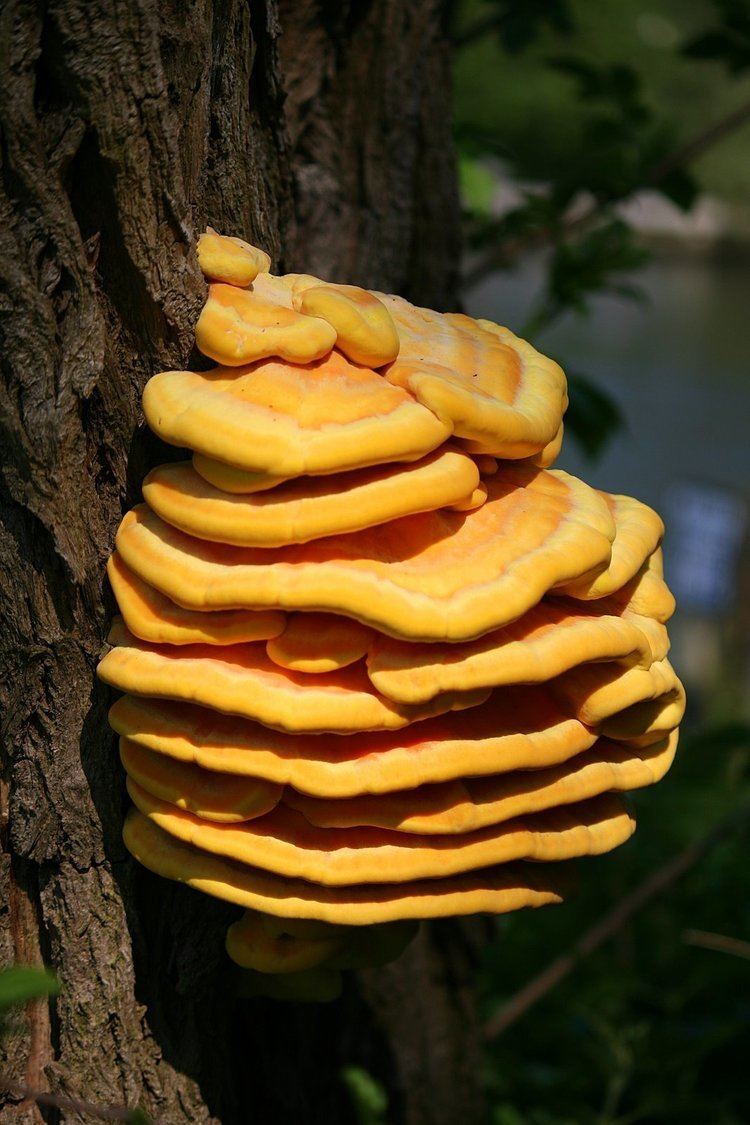 | ||
Similar Sulphur shelf, Cerioporus squamosus, Beefsteak Fungus, Polyporus, Fomes fomentarius | ||
Laetiporus sulphureus bracket fungus fungi polyporaceae sulphur shelf
Laetiporus sulphureus is a species of bracket fungus (fungus that grows on trees) found in Europe and North America. Its common names are crab-of-the-woods, sulphur polypore, sulphur shelf, and chicken-of-the-woods. Its fruit bodies grow as striking golden-yellow shelf-like structures on tree trunks and branches. Old fruitbodies fade to pale beige or pale grey. The undersurface of the fruit body is made up of tubelike pores rather than gills.
Contents
- Laetiporus sulphureus bracket fungus fungi polyporaceae sulphur shelf
- Chicken of the woods laetiporus sulphureus close up
- Taxonomy and phylogenetics
- Description
- Distribution and habitat
- Parasitism
- Guinness world record
- Palatability
- Allergic effects
- Medicinal
- Cultivation
- References
Laetiporus sulphureus is a saprophyte and occasionally a weak parasite, causing brown cubical rot in the heartwood of trees on which it grows. Unlike many bracket fungi, it is edible when young, although adverse reactions have been reported.
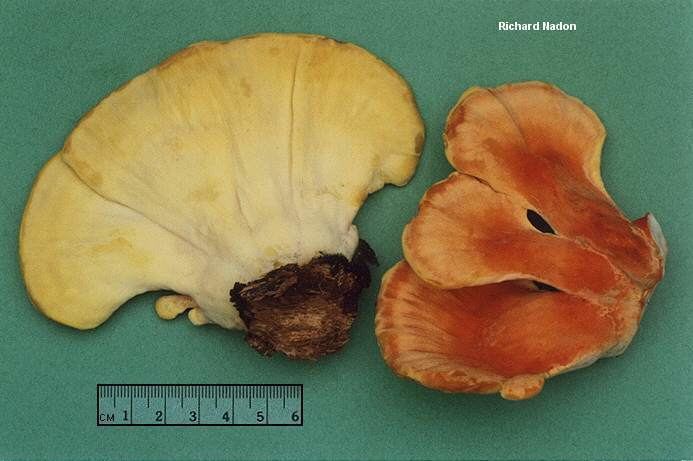
Chicken of the woods laetiporus sulphureus close up
Taxonomy and phylogenetics
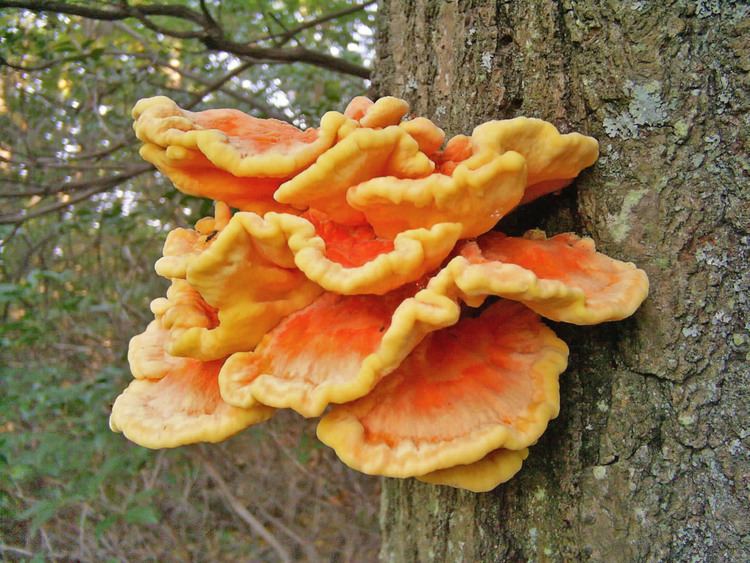
Laetiporus sulphureus was first described as Boletus sulphureus by French mycologist Pierre Bulliard in 1789. It has had many synonyms and was finally given its current name in 1920 by American mycologist William Murrill. Laetiporus means "with bright pores" and sulphureus means the colour of sulphur.
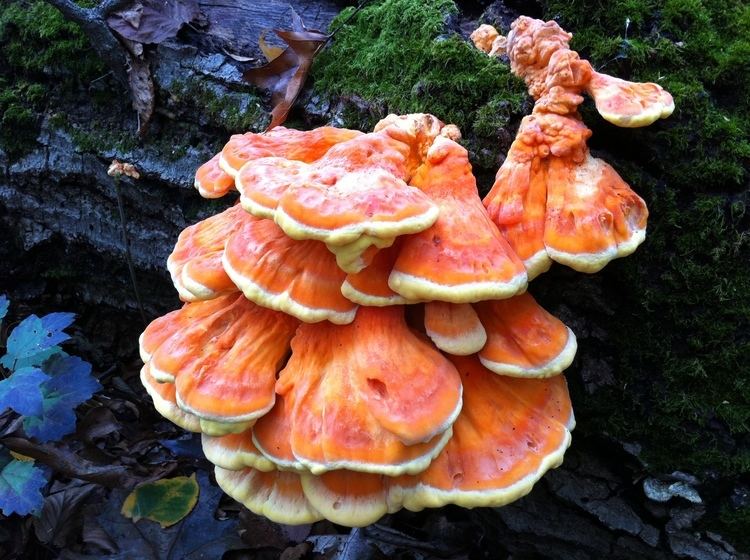
Investigations in North America have shown that there are several similar species within what has been considered L. sulphureus, and that the true L. sulphureus may be restricted to regions east of the Rocky Mountains. Phylogenetic analyses of ITS, nuclear large subunit and mitochondrial small subunit rDNA sequences from North American collections have delineated five distinct clades within the core Laetiporus clade:
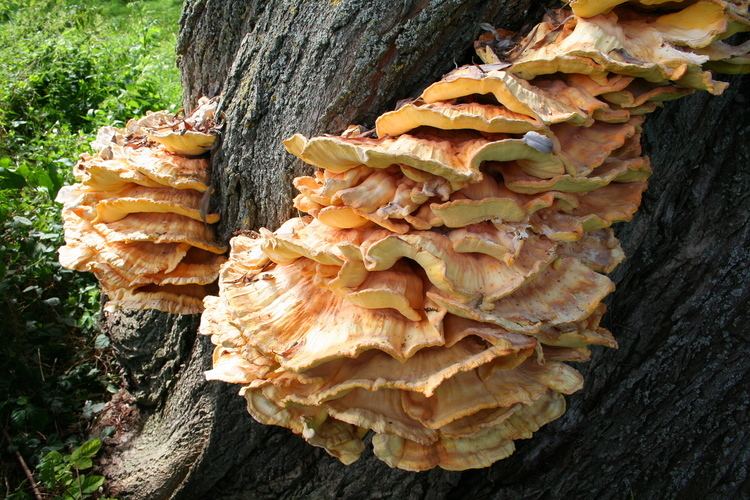
Description
The cap is attached directly to the trunk of a tree and is initially knob-shaped, but soon expands to fan-shaped, typically growing in overlapping tiers. It is sulphur-yellow to bright orange in colour and has a suedelike texture. Old fruitbodies fade to tan or whitish. Each shelve may be anywhere from 5 to 60 cm (2 to 23.5 in) in diameter and 4 cm (1.5 in) thick. The fertile surface is sulphur-yellow with small pores or tubes and has a white spore print. When fresh, the flesh is succulent and exudes a yellowish juice, but soon becomes dry and brittle. It has a strong, fungusy smell.
Distribution and habitat
Laetiporus sulphureus is widely distributed across Europe and North America though may be restricted to east of the Rockies.
It grows on dead or mature hardwoods and has been reported from a very wide range of host trees, such as Quercus, Prunus, Pyrus, Populus, Salix, Robinia, and Fagus, occasionally also from conifers, from August to October or later, sometimes as early as June. In the Mediterranean region, this species is usually found on Ceratonia and Eucalyptus. It can usually be found growing in clusters.
Parasitism
The mushroom causes brown cubical rot on the heartwood in the roots, base and stem. At first the wood is discoloured yellowish to red. Later on it becomes reddish-brown and brittle. At the last stage the wood can be rubbed like powder between the fingers.
Guinness world record
A specimen weighing 100 pounds (over 45 kg) was found in the New Forest, Hampshire, United Kingdom, on 15 October 1990.
Palatability
Because of the taste, the mushroom has been called chicken polypore and chicken-of-the-woods. Many people think that the mushroom tastes like crab or lobster. The authors of Mushrooms in Color said that the mushroom tastes good sauteed in butter or prepared in a cream sauce served on toast or rice. It is highly regarded in Germany and North America.
Young specimens are edible if large amounts of a clear watery liquid comes out of it. The mushroom should not be eaten raw. Deer like to eat the mushroom.
Allergic effects
Some people have had gastrointestinal upset after eating this mushroom, and it should not be consumed raw.
Studies have shown severe adverse reactions, including vomiting and fever, in about 10% of the population, but this is now thought to be a result of confusion with morphologically identical species such as Laetiporus huroniensis which grows on hemlock trees, and L. gilbertsonii which grows on Eucalyptus.
Medicinal
The mushroom produces the Laetiporus sulphureus lectin (LSL) which has haemolytic and haemagglutination activities. Haemolytic lectins are sugar-binding proteins that lyse and agglutinate cells. The haemagglutination and haemolytic activity are started by binding carbohydrates.
Cultivation
Compared with species such as Agaricus bisporus (button mushroom) and oyster mushroom, commercial cultivation of Laetiporus is limited. However, it can be cultivated; the most dependable and rapid production of this mushroom is cultivation of it indoors. The mushroom may or may not require the heat and water that gilled mushrooms do, depending on the strain. The mushroom is sensitive to carbon dioxide levels and light conditions. Artificial cultivation on synthetic substrate has been achieved.
